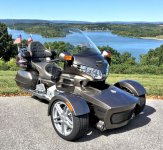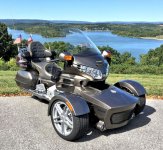Navigation
Install the app
How to install the app on iOS
Follow along with the video below to see how to install our site as a web app on your home screen.
Note: This feature may not be available in some browsers.
More options
You are using an out of date browser. It may not display this or other websites correctly.
You should upgrade or use an alternative browser.
You should upgrade or use an alternative browser.
Reverse Trikes
- Thread starter W3JNP
- Start date
Gorilla
Senior Moderator
welcome aboard nice trike
I don't yet have a reverse trike but that is direction I'm leaning. No pun intended with the leaning part.
But questions for you. Is that all trunk space up front? And does a heavy load change how it handles if it is trunk space?:Shrug:
My personal choice if they have it completed though is a leaning reverse trike by Tilting Motor Works. But I don't really care for their looks right now. It's a function over looks thing for me though.
But questions for you. Is that all trunk space up front? And does a heavy load change how it handles if it is trunk space?:Shrug:
My personal choice if they have it completed though is a leaning reverse trike by Tilting Motor Works. But I don't really care for their looks right now. It's a function over looks thing for me though.
W3JNP
100+ Posts
- Thread starter
- #4
I don't yet have a reverse trike but that is direction I'm leaning. No pun intended with the leaning part.
But questions for you. Is that all trunk space up front? And does a heavy load change how it handles if it is trunk space?:Shrug:
My personal choice if they have it completed though is a leaning reverse trike by Tilting Motor Works. But I don't really care for their looks right now. It's a function over looks thing for me though.
The front is trunk space. I haven't put anything heavy in it as yet so cannot comment on how it may impact handling.
I did take a GWRRA 3-wheel course with it and can tell you it handles better and is more stable than a conventional trike.
I thought I would miss the "lean" when going to a trike but found out I don't. The trike is very sporty in handling and fun to ride.
paws
Just Killing Time...
I did take a GWRRA 3-wheel course with it and can tell you it handles better and is more stable than a conventional trike.
Could you explain the stability comparison?
In what way did you find this trike more stable than a conventional trike?
Thanks..
Could you explain the stability comparison?
In what way did you find this trike more stable than a conventional trike?
Thanks..
W3JNP
100+ Posts
- Thread starter
- #6
I did take a GWRRA 3-wheel course with it and can tell you it handles better and is more stable than a conventional trike.
Could you explain the stability comparison?
In what way did you find this trike more stable than a conventional trike?
Thanks..
I've ridden trikes from Motor Trike and Hannigan and the owners of those have ridden mine and we have compared notes. We are all in agreement that the reverse trike is more stable and corners better.
There is an explanation of the advantages of a reverse trike compared to a standard trike in terms of handling at this web site for Endeavor Trikes: https://endeavortrikes.com/why-reverse/
paws
Just Killing Time...
Rider Magazine, January 2017 issue, has a brief ride-test report by Eric Trow. Not a very in-depth article but he did mention that steering was not particularly light..especially at very low speeds. I wish he had done a more comparative test (reverse vs. conventional trike) that would have included particulars like mileage. I like the fact that the saddlebags were kept but wonder about that snub flat nose ground clearance. As you get more miles on the trike possibly you could update us from time to time as to your findings...inquiring minds want to know! Enjoy it !!
W3JNP
100+ Posts
- Thread starter
- #9
Rider Magazine, January 2017 issue, has a brief ride-test report by Eric Trow. Not a very in-depth article but he did mention that steering was not particularly light..especially at very low speeds. I wish he had done a more comparative test (reverse vs. conventional trike) that would have included particulars like mileage. I like the fact that the saddlebags were kept but wonder about that snub flat nose ground clearance. As you get more miles on the trike possibly you could update us from time to time as to your findings...inquiring minds want to know! Enjoy it !!
I've attached two replies that I wrote on another forum. Hopefully these will answer any questions you may have about a wheels front trike.
I’m new to the three wheeled world. In fact, as of this writing I’ve only accumulated around 3,000 trike miles. While admittedly a new triker I am in no way new to motorcycling.
For the last few years my body has been telling me that if I wanted to continue riding that a trike would be in my future. Grudgingly I gave into my failing knees and made arrangements to have my 2004 GL1800 converted into a reverse trike.
While waiting for my bike to come back out of the shop I took advantage of enrolling in a GWRRA trike course scheduled in Gettysburg, PA on October 1[SUP]st[/SUP].
Once my newly converted bike came out of the shop on September 14[SUP]th[/SUP] I was able to accumulate around 1,500 miles before attending the course.
It was during this time that I noted several differences when riding on three wheels as opposed to riding on two. The following observations are not in any particular order and a few of which are specific to my reverse trike as opposed to a convention two in the rear trike.
Here is what I found in a one liner format.
Filling gas is now easier. I do not have to put the bike on the center stand to get a full tank.
Parking is different as the bike could roll away easier than when on the side stand. I now always park in gear or in reverse. I also carry along a small set of wheel chocks and a wrap around Velcro strap for the hand brake. My bike also has a ride off center stand that works very well for parking use.
Road/tire/engine noise is louder and I now have to turn the volume up on the radio a bit to hear it clearly.
Turbulence from trucks is handled better. I still feel it but the effect is noticeably less.
Side wind loads are also still felt but handled better.
When riding in the rain the water thrown by the front tires is blocked by the fenders and my feet do not get as wet. I’ve added mud flaps but only because I like the look.
Air getting to my feet and lower leg is also reduced. My passenger also noticed a difference in the amount of air she feels hitting her legs.
Steering at low speed vs. highway - Slow speed steering is heavy but easily managed. At highway speeds steering is much lighter and very quick, but easy to get accustomed to.
Slow speed turn radius is almost as good at full lock but not as tight as with being able to lean. Conventional two in the rear trikes can turn tighter than I am able.
Traffic light trip plates no longer seem to be a problem. There is a light with trip plate near my home that never worked for my bike but always works with the car. It now works with the trike.
Judging width is not an issue as the two front wheels are in my peripheral vision.
Standing up at traffic lights to stretch when I have a little butt burn is no problem as I don’t have to balance the bike.
Two up balancing while stopped at traffic lights and especially on uneven roads or over a pothole is no longer a factor.
Balancing the bike while my passenger gets on is now a non issue.
Same engine temperature as before when riding on the highway, slightly higher in stop & go at 90 degrees. Not close to overheating.
Speed bumps & driveway entrances – bottoms out if not careful, must go slowly or at an angle.
Twitchy passenger – no notice to her moving about now.
Grated bridges & grooved roads are no problem at all.
Standing the bike up from the side stand & putting it back down when getting off is a thing of the past.
No more dents in the driveway from the side stand!
Gravel spots on the roads & wet leaves are much less of a concern now. Almost like driving in a car.
Backing up from parking spaces etc. is easier as you do not have to balance the bike and can push more effectively when you are not using reverse.
Pot holes & bumps have to be handled differently. If you can’t go around it you have to decide in advance how to take it. The independent front suspension seems to handle it better ride wise than taking the bump with the back tire.
Can’t drop the bike.
Linked brakes – Still activated. The hand brake only controls two of the three front pistons on each wheel. The foot brake controls the remaining front piston plus the rear brake. The bike will hold a straight line when the brakes are applied. Stopping distance is close to the same as with two wheels. I think the extra tire width may help with offsetting the added weight of the trike kit.
Nose dive is almost completely gone in a rapid stop.
Steeper curves at highway speeds require a little technique as it feels like centrifugal force wants to pull you off the bike. Leaning into the turn while pressing down with the outside foot makes a big difference. Slowing down before the turn and rolling the throttle coming out make the turn just a smooth as when on 2 wheels. Locking the elbow of my outside arm also makes a positive difference.
Gas mileage took a hit. The extra weight and wind drag costs me 2 to 3 mpg. The benefit to my knees make the MPG hit worth while.
The trike is fun to ride. Thought I would miss 2 wheels. I don’t.
My bike always had a nice comfortable ride. It has actually improved with the reverse trike kit. The independent front suspension and lower tire pressures make a big difference.
Loading and then securing it to a trailer will be way easier.
Not sure if I still need the belly pan but I’m leaving it on.
Side notes:
No problem getting to the oil filter and oil and coolant drain plugs for fluid changes.
Cleaning bugs out from behind the grill is a pain.
No one makes a fitted cover that will cover the whole reverse trike. A half cover does a good job keeping the rear trunk, seat, handlebars and the area from the windshield back covered.
I’ll never have to change fork oil or fork seals again! Bleeding the brakes will also be easier.
The new front end requires far less maintenance than the old forks. Only maintenance to it are two lube points (one on each side).
Cleaning the windshield is harder as the trunk and fenders get in the way. Not a big deal, really.
When parking on a lot I need an entire space. No more sharing the same space with other bikes.
When I stop somewhere I need to be ready for lots of questions from both other bikers and the general public.
Drive up windows like at the bank and toll booths require me to either get off the bike or lean way over.
In my case with a reverse trike I actually gained storage space as opposed to losing any or staying near the same.
These are the things I noticed thus far. I’m sure there will be more over time. Hopefully this will answer some questions you may have if you have been considering triking your bike. Most of my comments apply equally to two in the front as opposed to two in the rear trikes.
I’d also like to take a moment and share what techniques I’ve had to learn as a new trike rider.
Let me get one thing clear from the start. I’m a new trike owner/rider and not any type of motorcycle safety instructor.
I’ve ridden on two wheels for many many years but had to learn some new things when switching over to a trike.
My problem was there is no real good advice in any one spot for the new trike rider.
I read everything I could online and watched several YouTube videos, attended a GWRRA three wheel course, spoke to as many other trike owners as I could and learned by trial and error.
The two biggest things that I found which I needed to learn and master were steering and handling centrifugal force.
Steering was more of a hands on and do it skill and easy to become accustomed to. It didn’t take more than a few hundred miles to be comfortable at Turnpike speeds.
Curves require some technique, actually techniques, that once mastered not only manage the centrifugal force but allow for better cornering than when on two wheels.
When I say centrifugal force I’m referring to the feeling that you are being pulled off the trike when cornering or taking a curve. The faster you go, the stronger this feels.
I’m like to share what I have found that works for me.
Let me start with your hands. You have them on the handlebars and they sure do help you hang on. Locking the outside elbow when you turn makes a nice difference. For example, when turning left, lock the right elbow. You are pulling with your left hand and pushing with your right. Be careful on left turns that as you lock your arm you do not also twist the throttle and increase your speed. You may have to change your grip a bit lower on the throttle to prevent this from happening.
Slowing before entering the turn then entering high, going low and coming out high is the same as when on 2 wheels, as is the smooth application of throttle as you come out of the turn and a steady speed through the turn. You still need to lean. Since the trike won’t lean then you have to. Lean into the turn and also lean slightly backward. Do not lean forward. Leaning slightly backward helps keep the elbow locked and pushes you into the back of your seat which helps hold you in place.
Push down on the foot peg with your outside foot. When turning left push down with your right foot. You’ll also want to bring your inside knee in against the fuel tank. Doing these help hold you on the bike and give you a more secure feeling.
Two things you may wish to change on your bike if you don’t already have them are a backrest and floorboards.
Floorboards allow you to keep your feet flat and give you better balance and pushing area with your feet than just pegs. These make a nice difference. I switched over about 1,000 miles ago and noticed the difference immediately. Note – depending on the floorboards you choose you may also need to go to a heel/toe shifter if you can’t get your toes under the shifter peg. I prefer the heel/toe shifter but know others do not like it.
A backrest makes a huge difference. As you lean slightly backward, lock your elbow and push with your outside foot you will be pushed more firmly into the backrest. This will help hold you in place more securely. The curve in your backrest will support the side of your body and absorbs a lot of the pull on you. My backrest is detachable and I did some testing with it on and off. As a result it is on full time now as it made the biggest difference in feeling secure when turning.
I’ve found that these combination of techniques quickly become automatic and I don’t even think about doing them now. When I ride on roads that I frequent, like curved highway on ramps, I find that I can negotiate them, while feeling comfortable, at a higher speed then when I was on 2 wheels.
This has been my experience. I hope what I’ve shared may be of some use for you.
I’d sure be interested in anything anyone else has found that works for them.
Attachments
Are there any other reverse trike owners here?
I ride a Motor Trike Prowler RT which I had converted in late September.
I'm impressed with how well it handles and the comfort of the ride.
I have now joined this Forum. As you can see by my Avatar I have the Hannigan RT conversion, but you already knew that W3JNP.ThumbUp
consitter
Bob's Curmudgeon Apprentice
Great trike! Welcome to the forum!
very nice write up on your learning curve. a lot of what you wrote applies the same as the Spyder. reverse trikes offer much more of a stable & comfortable ride. the one thing I discovered was using less grip actually allows for a smoother ride. sounds crazy but it does work. a whole lot less twitching. i can now easily leave just about any other trike in the twisties.
kind of curious on your foot brake, does your floor board give way if you really stand on the brake? I couldn't tell by the pic that you posted.
kind of curious on your foot brake, does your floor board give way if you really stand on the brake? I couldn't tell by the pic that you posted.
very nice write up on your learning curve. a lot of what you wrote applies the same as the Spyder. reverse trikes offer much more of a stable & comfortable ride. the one thing I discovered was using less grip actually allows for a smoother ride. sounds crazy but it does work. a whole lot less twitching. i can now easily leave just about any other trike in the twisties.
kind of curious on your foot brake, does your floor board give way if you really stand on the brake? I couldn't tell by the pic that you posted.
On the twitchiness. That's only true with Spyders I think as they have a power steering type set-up.
On the break-away brake. That too is only with Spyders I believe.
It's a great feature but I think other reverse trikes still have front brakes where Spyders don't. Well they do but they work off just the foot brake pedal where others still have a front brake lever. Hope I didn't confuse that too much.:Shrug:
Gorilla
Senior Moderator
welcome aboard nice conversion
Seems to me . . .
that there is a reason why arrowheads and ship's bows are pointed and automobiles are increasingly aerodynamic and conventional trikes have narrow front ends. When I see a reverse-trike, I see a barge pushing a wall of water upstream rather than a clipper.
that there is a reason why arrowheads and ship's bows are pointed and automobiles are increasingly aerodynamic and conventional trikes have narrow front ends. When I see a reverse-trike, I see a barge pushing a wall of water upstream rather than a clipper.
Tire Pressures Reverse Trike
Hi Guys, Keen to know what tire pressures you run in your front car and rear car tires on your Prowlers.? How have you noticed the correct pressures on handling?
Hi Guys, Keen to know what tire pressures you run in your front car and rear car tires on your Prowlers.? How have you noticed the correct pressures on handling?
I’ve ridden on two wheels for many many years but had to learn some new things when switching over to a trike.
My problem was there is no real good advice in any one spot for the new trike rider.
I read everything I could online and watched several YouTube videos, attended a GWRRA three wheel course, spoke to as many other trike owners as I could and learned by trial and error.
The two biggest things that I found which I needed to learn and master were steering and handling centrifugal force.
Steering was more of a hands on and do it skill and easy to become accustomed to. It didn’t take more than a few hundred miles to be comfortable at Turnpike speeds.
Curves require some technique, actually techniques, that once mastered not only manage the centrifugal force but allow for better cornering than when on two wheels.
When I say centrifugal force I’m referring to the feeling that you are being pulled off the trike when cornering or taking a curve. The faster you go, the stronger this feels.
I’m like to share what I have found that works for me.
Let me start with your hands. You have them on the handlebars and they sure do help you hang on. Locking the outside elbow when you turn makes a nice difference. For example, when turning left, lock the right elbow. You are pulling with your left hand and pushing with your right. Be careful on left turns that as you lock your arm you do not also twist the throttle and increase your speed. You may have to change your grip a bit lower on the throttle to prevent this from happening.
Slowing before entering the turn then entering high, going low and coming out high is the same as when on 2 wheels, as is the smooth application of throttle as you come out of the turn and a steady speed through the turn. You still need to lean. Since the trike won’t lean then you have to. Lean into the turn and also lean slightly backward. Do not lean forward. Leaning slightly backward helps keep the elbow locked and pushes you into the back of your seat which helps hold you in place.
Push down on the foot peg with your outside foot. When turning left push down with your right foot. You’ll also want to bring your inside knee in against the fuel tank. Doing these help hold you on the bike and give you a more secure feeling.
Two things you may wish to change on your bike if you don’t already have them are a backrest and floorboards.
Floorboards allow you to keep your feet flat and give you better balance and pushing area with your feet than just pegs. These make a nice difference. I switched over about 1,000 miles ago and noticed the difference immediately. Note – depending on the floorboards you choose you may also need to go to a heel/toe shifter if you can’t get your toes under the shifter peg. I prefer the heel/toe shifter but know others do not like it.
A backrest makes a huge difference. As you lean slightly backward, lock your elbow and push with your outside foot you will be pushed more firmly into the backrest. This will help hold you in place more securely. The curve in your backrest will support the side of your body and absorbs a lot of the pull on you. My backrest is detachable and I did some testing with it on and off. As a result it is on full time now as it made the biggest difference in feeling secure when turning.
I’ve found that these combination of techniques quickly become automatic and I don’t even think about doing them now. When I ride on roads that I frequent, like curved highway on ramps, I find that I can negotiate them, while feeling comfortable, at a higher speed then when I was on 2 wheels.
This has been my experience. I hope what I’ve shared may be of some use for you.
I’d sure be interested in anything anyone else has found that works for them.
WOW I wish this was written when I first got my trike. I have taught myself most of these now, but locking the elbow and leaning I will concentrate more on. THANK YOU so much.
About the ONLY addition I would make is regarding passenger mods. Mine had fine footboards in front, but pegs in back for Mrs V. Making matching floorboard mounts in the rear increased her riding pleasure and comfort. I would even say it turned it from a tense 'hang on the bird perches' to a comfortable 'Relax in a chair' for her.
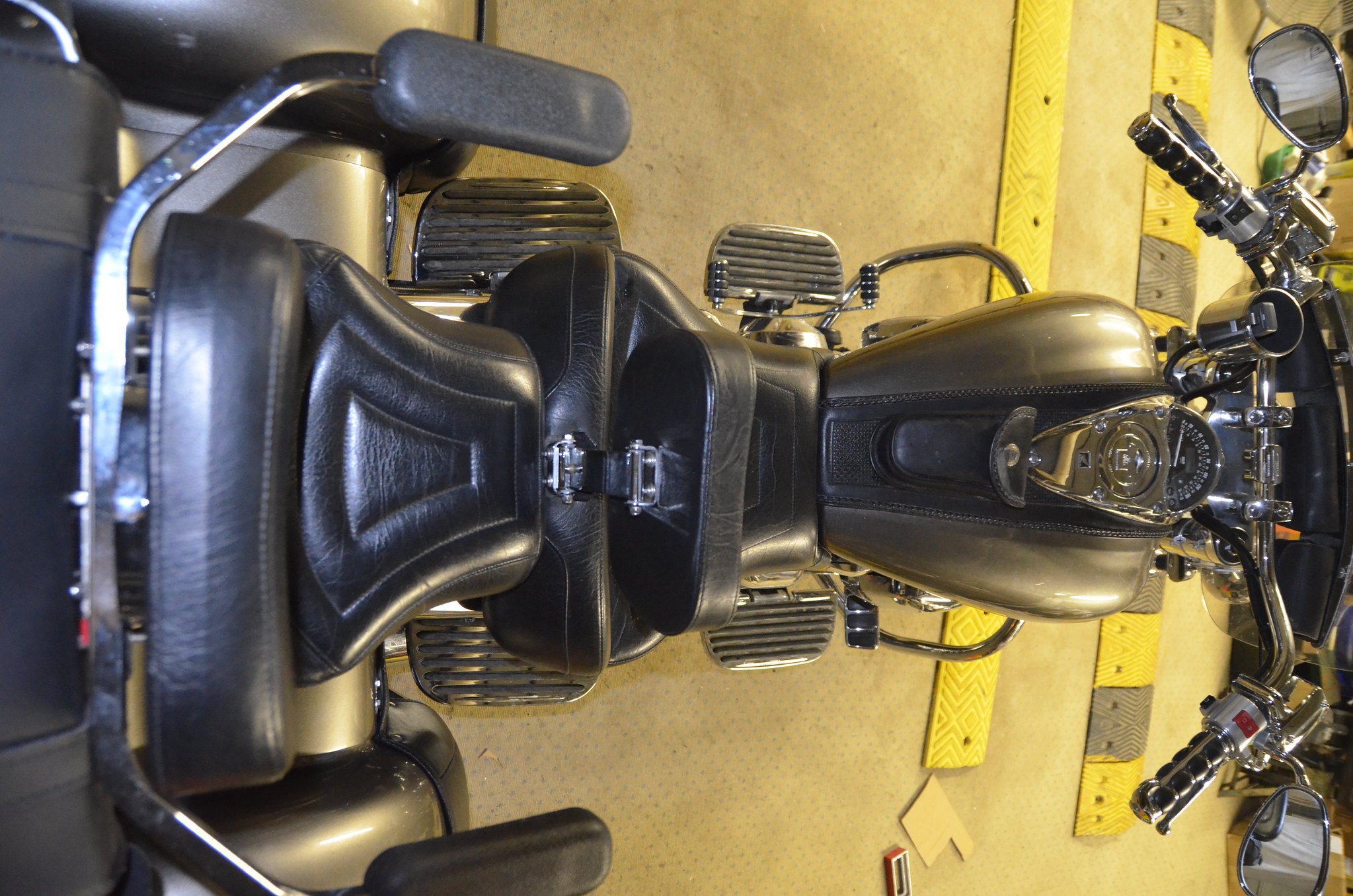
The other was armrests. Mine came with, and they are probably Mrs V's FAVORITE item on the bike. They lift for mount/dismount. They offer her SO much more security than what she calls the 'nubby' armrests on other trikes.
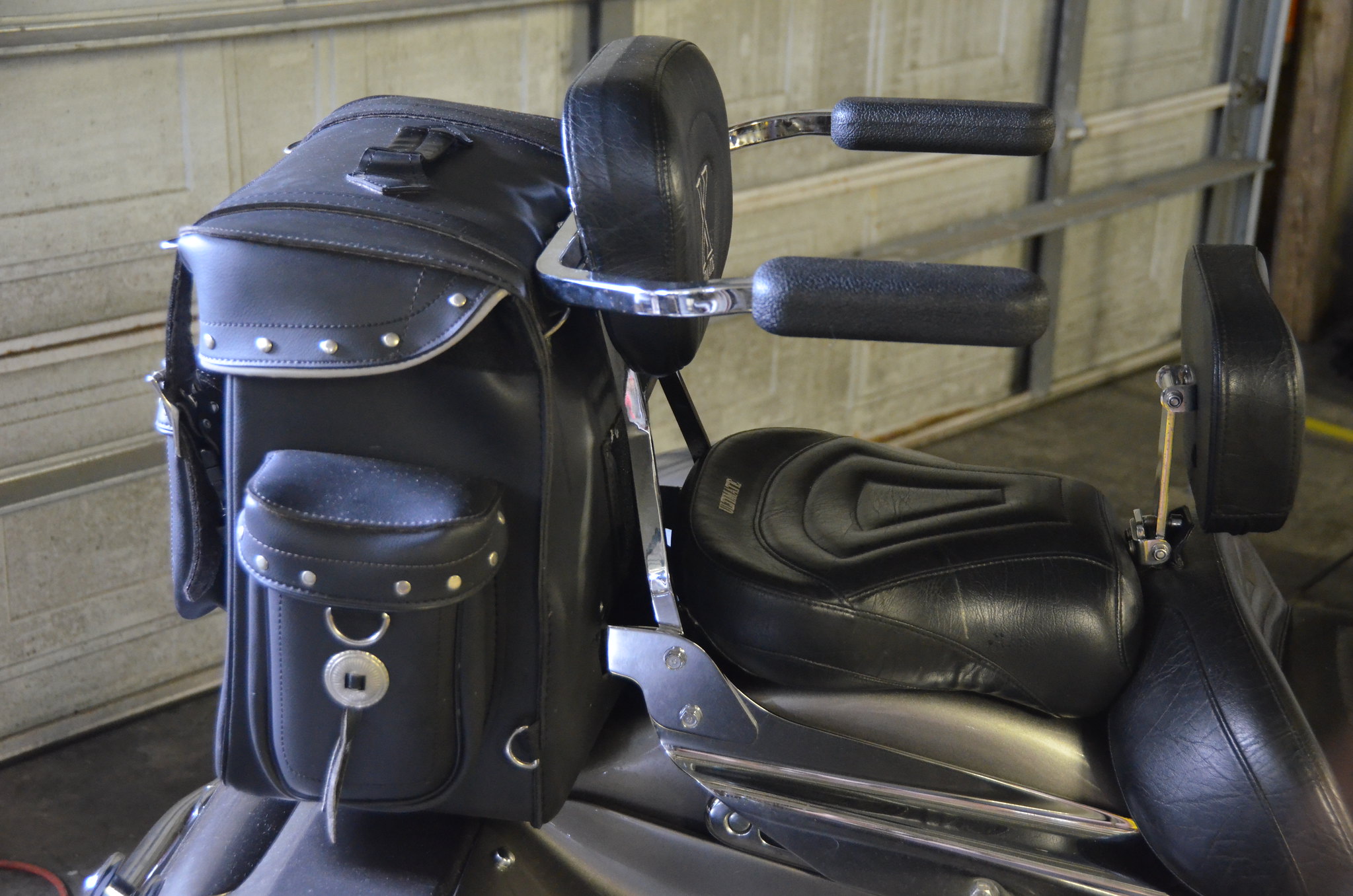
I really love the look of the single front/dual rear wheel trikes. I understand there may be better handling and ride to be had in the other style, but I did not like the lack of 'on a motorcycle' feel they gave me while operating. Felt more like I was perched on a convertible car. But I wave at ALL of them.
I'm late to the party as usual, just ran across this thread.
"When parking on a lot I need an entire space. No more sharing the same space with other bikes."
I just pull all the way forward and my 2 tired buddies park behind me on either side of my back tire. I make sure I can pull out going forward so I don't have to back up.
"When parking on a lot I need an entire space. No more sharing the same space with other bikes."
I just pull all the way forward and my 2 tired buddies park behind me on either side of my back tire. I make sure I can pull out going forward so I don't have to back up.
Glad to see others with wheels in the front. I run 15 psi in the front and 30 in the rear.
PROWLER RT on GL1800
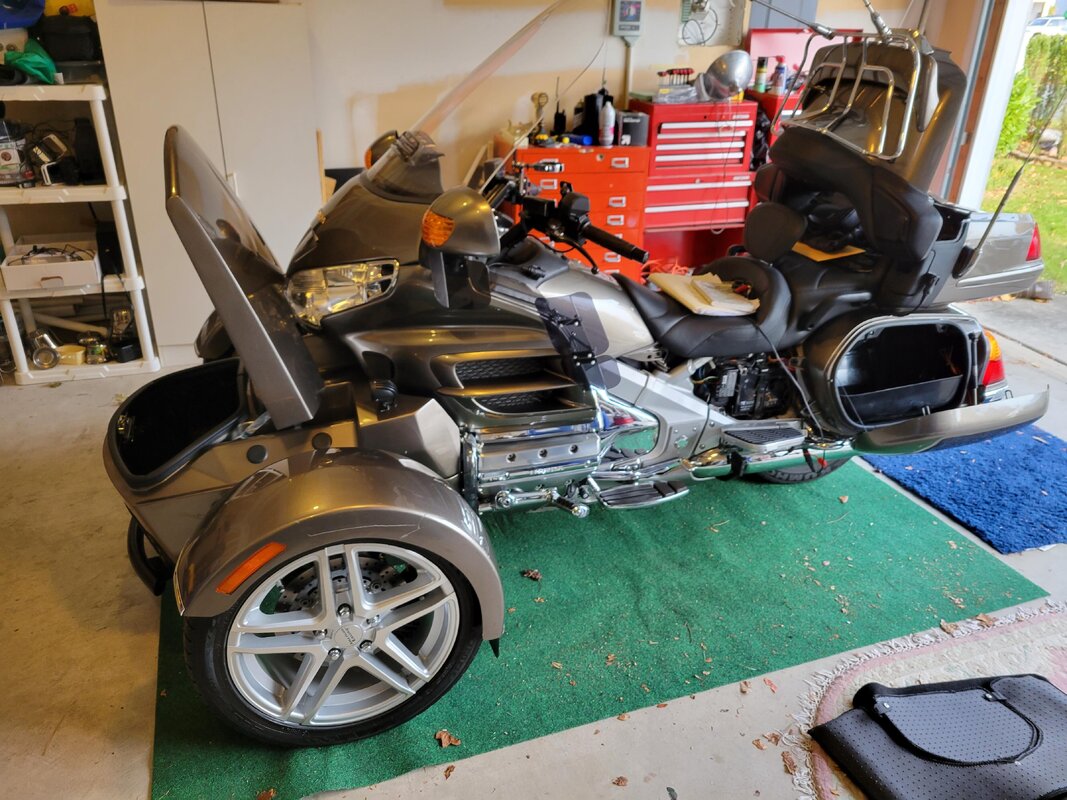
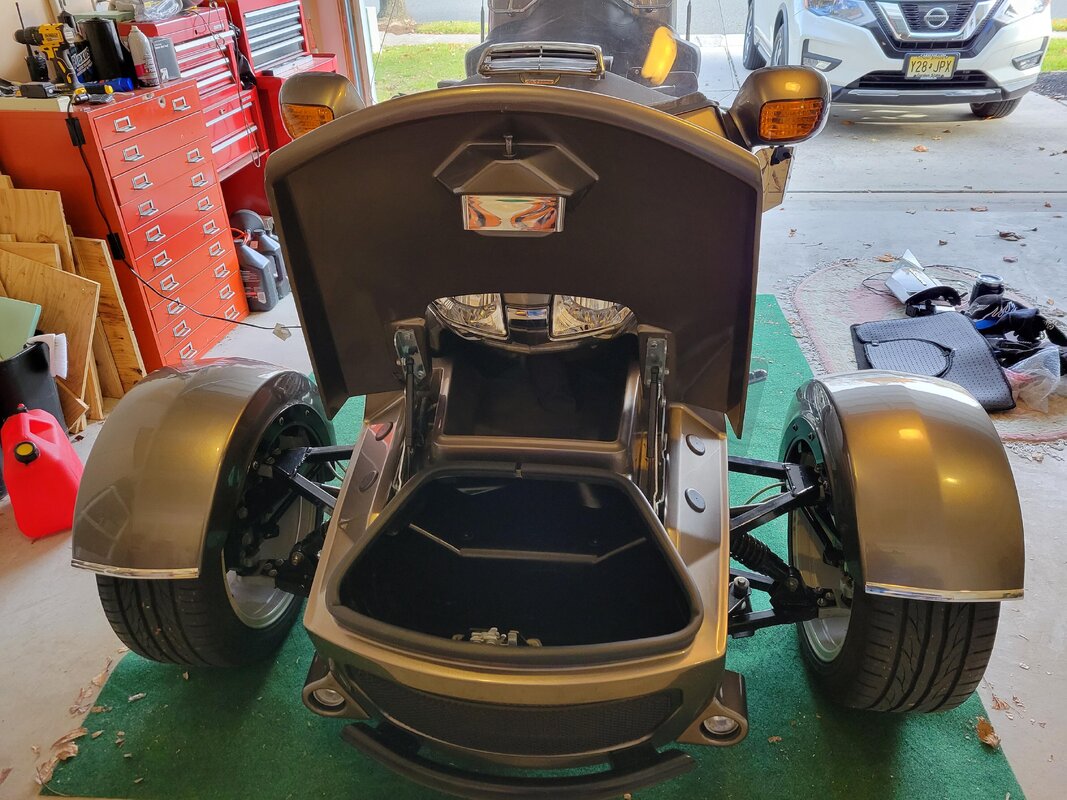 Nov. 27, 2021
Nov. 27, 2021
Welcome to the Prowler RT's. I just purchased my 2004 GL1800 with the Prowler RT. The only problem I find is that trying to make a U-turn on a small street is a bummer. Other than that I feel as though I am driving a tank. That is a good feeling for me. I already had 4 Canam Spyders and liked them very much, but decided to try something different.
It's NOT FUGLY, it's COOL and DIFFERENT.
Motogordo
p.s. What tire pressure are you using ? I have all auto tires on mine and it seems as though most are suggesting 18-24 in the front and 25 to 30 in the rear.

 Nov. 27, 2021
Nov. 27, 2021Welcome to the Prowler RT's. I just purchased my 2004 GL1800 with the Prowler RT. The only problem I find is that trying to make a U-turn on a small street is a bummer. Other than that I feel as though I am driving a tank. That is a good feeling for me. I already had 4 Canam Spyders and liked them very much, but decided to try something different.
It's NOT FUGLY, it's COOL and DIFFERENT.
Motogordo
p.s. What tire pressure are you using ? I have all auto tires on mine and it seems as though most are suggesting 18-24 in the front and 25 to 30 in the rear.
Welcome to the Trike Talk Community
Join our vibrant online community dedicated to all things Trikes! Whether you're a seasoned rider or just starting out, this is the place to share experiences, tips, and stories about your three-wheeled adventures. Explore modifications, maintenance advice, and rides, all while connecting with fellow trike enthusiasts from around the globe
Forum statistics
Trike Talk Community
Welcome to a community dedicated to the most diverse and fastest growing powersports segment, Motorcycle Trikes. Come join the discussion about the best makes and models, popular modifications and proven performance hacks, trike touring and travel, maintenance, meetups and more!
Register Already a member? LoginForum statistics







